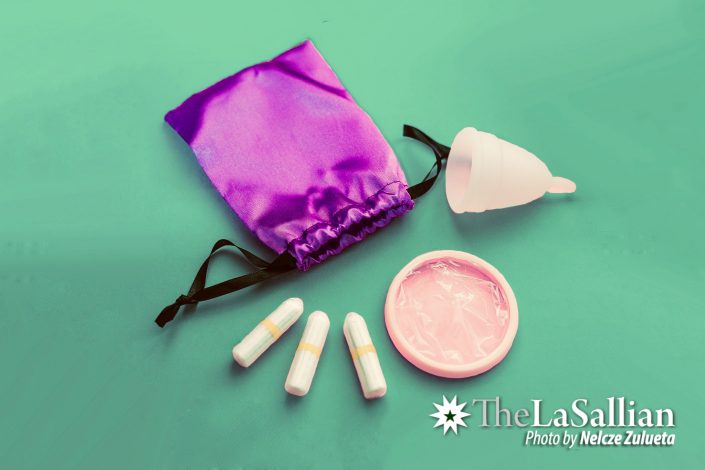With many millennials and members of Generation Z at the forefront of advocating for body positivity and sustainability movements, it is no surprise that the market for menstrual products is slowly being saturated with reusable options.
However, some of these may look uncomfortable at best to those who have not used them before. In fact, the fear of discomfort is one of the main reasons why many women hesitate to use products like the menstrual cup. Others also worry that it may get lost in one’s own vaginal canal, or that wearing one can “strip off” one’s virginity.
Concretizing efforts to clarify and to dispel misconceptions surrounding the formidable-looking yet popular menstrual cup, businesses like the Sinaya Cup—the first local brand of menstrual cups—make it a point to educate clients as well.

What are menstrual cups?
A menstrual cup is a reusable menstrual device, usually made out of silicone, that works by capturing menstrual fluid from within the body. Due to their smaller market, however, many women are apprehensive about using the device. While learning the process takes time, Sinaya Cup Community Manager Fenella Sto. Domingo lays out step-by-step instructions on how to put on and remove a menstrual cup.
Once sanitized, the menstrual cup should be folded to ease its insertion into the vagina. While there are many ways of folding the cup, the most common methods such as the c-fold help minimize the diameter of the cup during insertion. Once inside, the cup can be pushed until it can no longer go further. Then, it should be released, and once it pops open, this signals that suction is achieved. Suction is what allows the cup to stay in place and to prevent leaks by essentially creating a vacuum seal in the vaginal canal. In this state, no air can flow in and out of the cup, preventing bacterial growth, which means the risk of acquiring toxic shock syndrome (TSS) is negligible.
To remove the cup, one must break the suction by inserting a finger and pressing down on the side of the cup to fold it once again.
As such, Sto. Domingo notes that there is definitely a learning curve for women who opt to use menstrual cups. But she affirms that 84 percent of Sinaya Cup users master the trick in under three months, while a few others did so within a year. She says, “Every journey is different. Now, of course, it would be an easier—and more fun—journey if you have friends who are also using the cup to help you along.”
Making the switch
Some of the most well-known menstrual products are a cornucopia of plastic. Tampons are encased in plastic applicators with plastic strings dangling from one end, while many napkins incorporate plastic to absorb fluids. Many of these products end up in a landfill, clog sewers, or contribute to the staggering amount of plastic waste in our oceans.
Then there is the menstrual cup. In 2019, The Lancet reported that the bell-shaped device is just as effective at collecting period blood and preventing leaks as its mainstream counterparts. It also allows women to adopt sustainable period practices because it requires changing only once every 12 hours.
Another selling point is its longevity. Disposable menstrual products tend to lock women into a cycle of monthly purchases, while a single menstrual cup can last up to a decade because they are composed of medical-grade silicone.
For Effie* (I, PSYC), “It’s so much more guilt-free to use because of the effect of disposable products on the environment and thinking about the waste we both individually and collectively produce daily.”
Popping the cherry
Despite this, Filipinos still have plenty of reservations about insertable period products like tampons and menstrual cups.
According to Sto. Domingo, many customers are wary of experiencing pain while using the cup. “The vagina is a small opening and we don’t usually even look there, much less touch or put things inside,” she explains.
But the vagina is also flexible. Like an elastic band, it can stretch to accommodate the cup and then return to its original shape once the cup has been removed.
Other myths persist as well. Some people fear that using a menstrual cup can damage the hymen—a thin membrane that is often seen as proof of one’s virginity, like a fleshy shield that “breaks” or “pops” after a woman has sex for the first time. However, it has been shown that the hymen naturally wears away as we go through adolescence. In fact, some girls are even born without one.
Virginity can be a divisive subject. In the Philippines, it is usually imbued with spiritual significance. This feeds into the problematic idea that women should only be allowed to use certain menstrual products, slowing down the acceptance of alternatives.
Achieving period equity
The menstrual product landscape has evolved considerably over the years as eco-friendly innovations continue to emerge. Other options include reusable pads, period underwear, and menstrual discs. Although these products may be on some women’s radars, they still only hold a small piece of the market.
The silence around alternatives continues due to the social taboos surrounding menstruation. Despite being experienced by half of the global population, it is still largely discussed behind closed doors. For Sto. Domingo, educating people about this subject is important not only in raising awareness around menstrual products but also in championing the needs of women.
Apps that track women’s menstrual cycle and online campaigns like #FreePeriodStories have already gone a long way towards lifting the veil that exists around the subject. Continuously reframing current attitudes is key in attaining period equity—a future where every woman can hygienically and sustainably manage her periods.
*Names with asterisks (*) are pseudonyms.
